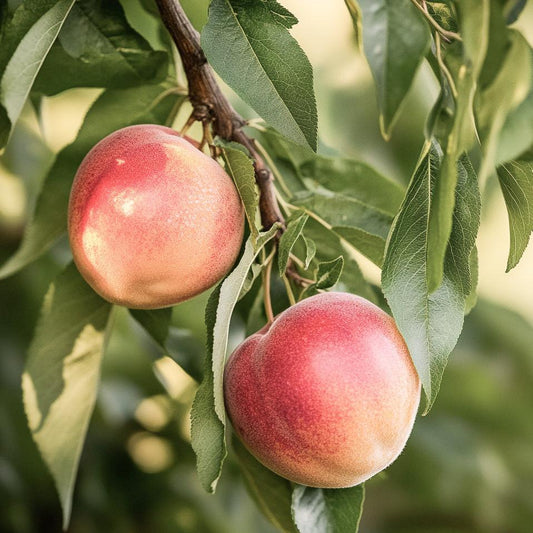Healthy Bare Root Nectarine Trees | Sweet, Juicy Homegrown Fruit
Explore our selection of nectarine trees, including popular varieties like the Snow Queen and Harko. Our bare root nectarine trees are ideal for home orchards, offering a beautiful addition with medium-sized growth and delicious, sweet juicy fruit.
Growing Nectarine Trees (Prunus persica var. nucipersica)
Nectarine trees (Prunus persica var. nucipersica) are close relatives of peaches, producing smooth-skinned fruits with a variety of flesh colors, including white-fleshed and yellow flesh types. These fruiting trees thrive in USDA hardiness zones 5 through 9 and require specific chill hours to properly bear fruit.
-
Tree Size: Typically medium-sized, perfect for smaller orchards or backyard gardens.
-
Fruit Type: Smooth-skinned nectarines, distinguished from fuzzy peaches.
-
Uses: Great for eating fresh, baking, preserves, and salads.
Varieties of Nectarine Trees
Our collection features several well-known nectarine varieties such as:
-
Snow Queen Nectarine Tree – known for its firm, flavorful fruit and reliable fruit production.
-
Harko Nectarine Tree – a unique variety with distinct growth habits, producing delicious nectarines with a balance of sweetness and tartness.
-
Heavenly White Nectarine Tree – a white nectarine tree variety prized for its mild flavor and smooth skin.
Care and Cultivation
Proper care helps your nectarine tree thrive and maximize fruit yields. Key points include:
-
Pruning: Regular pruning encourages healthy growth, improves air circulation, and reduces risks like peach leaf curl.
-
Chill Hours: Each variety requires specific chill hours for optimal flowering and producing fruit.
-
Soil: Well-drained soil and full sun exposure are essential.
-
Pest Management: Monitor for common issues such as peach leaf curl and aphids.
Harvest and Fruit Characteristics
Nectarines typically ripen from early to late summer, depending on the nectarine variety and location. Fruits are sweet juicy with either white-fleshed or yellow flesh, offering a delicious harvest for fresh enjoyment.
- Ripen when fruit shows vibrant color and slight softness.
- Store ripe nectarines refrigerated to extend freshness.
- Continue ripening after harvest but watch for quality issues like bacterial spot.
Why Choose Our Nectarine Trees?
- Bare root nectarine trees ensure healthy, vigorous starts.
- Carefully selected Prunus persica varieties adapted to various hardiness zones.
- Trees produce high-quality, sized fruit with consistent yields.
Growing your own nectarine tree is a rewarding way to enjoy the beauty of spring blossoms and the sweetness of summer fruit. Perfect for home orchards and backyard gardens, these bare root nectarine trees offer vigorous growth, manageable size, and reliable harvests in USDA Zones 5–9.
Whether you choose the classic Snow Queen, the flavorful Harko, or the fragrant Heavenly White, each tree promises delicious, smooth-skinned fruit ideal for fresh eating, baking, or preserves. With proper care—regular pruning, good sun exposure, and attention to chill hours—you’ll enjoy consistent yields and high-quality fruit for years to come.
At Grow Organic, our bare root nectarine trees are carefully selected for health, flavor, and performance, helping gardeners grow successfully from root to harvest. Plant one today and enjoy the simple joy of picking sweet, sun-warmed nectarines straight from your own tree.
Additional Resources
For expert guidance on planting, pruning, and managing peaches and nectarines, refer to these valuable resources:
-
Illinois Extension: Comprehensive guides on nectarine tree pruning, training, and revitalizing old trees to improve fruit production.
-
MU Extension, Missouri: Detailed information on selecting cultivars, soil preparation, and proper planting techniques for peaches and nectarines.
-
Ohioline, Ohio State University: Practical advice on site selection, cultivar recommendations, and training systems to maximize nectarine yields.
-
University of Maryland Extension: Covers common challenges like late spring frosts, pests, and diseases affecting stone fruit trees.
-
Clemson University Home & Garden Information Center: Focuses on soil requirements, fertilization, and pruning for healthy peach and nectarine trees.
-
Comprehensive Guide to Growing Nectarines: Step-by-step instructions on cultivating nectarines for optimal growth and fruit production.
-
Harvesting and Post-Harvest Handling of Nectarines: Tips on when and how to harvest nectarines and maintain their freshness.
-
Pest and Disease Management for Nectarine Trees: Effective strategies to identify and control common nectarine tree pests and diseases.
-
Seasonal Care and Maintenance of Nectarine Trees: Guidance on caring for nectarines throughout the growing season for sustained health.
-
Propagation Techniques for Nectarines: Methods for successfully propagating nectarine trees to expand your orchard.
Grow delicious nectarines year after year with our nectarine trees for sale—perfect for those who want flavorful fruit and beautiful fruiting trees in their garden.
 Sold out
Sold out Sold out
Sold out Sold out
Sold out














